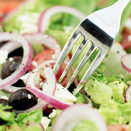Salad in a Snap
View All Section Pages

Salads are such a versatile food. They can be meal starters, side dishes or stand-alone complete entrees. The key to consuming them on a regular basis is to keep them simple yet flavorful.
Cooper Clinic Registered Dietitian, Elana Paddock, RD, LD, CDE, has a step-by-step guide on how to build a snazzy salad.
Start With the Greens
Most salads are built on a field of lettuce. Pile on volumes of greens that are full of filling fiber and very low in calories (10 calories or less per cup). Pass on the pale iceberg lettuce in favor of the dark green varieties that are more nutrient dense. Popular ones include romaine, mixed greens, baby spinach and bibb lettuce. Branch out a little bit and throw in some kale or chopped cabbage.
Mix in a Rainbow
There are slew of brightly colored veggies you can toss atop the bed of greens. Aim to pile in as many different colors as you can. Think beyond the usual salad fix-ins like carrots, cucumbers, celery and tomatoes. Get creative with sugar snap peas, yellow squash and red and orange bell peppers.
Salads are sweeter with fruit accents such as chopped apples and pears, sliced strawberries, Clementine wedges and dried cranberries. Who says salads should only contain raw produce? Lightly steam up some veggies like broccoli, zucchini or slices carrots, and squeeze on some lemon juice for a flavor punch.
Pack in Some Protein and Bits of Healthy Fat
If you’re making a meal out of a salad, it’s especially important to top it with some hunger-sustaining protein foods. Aim for 10-15 grams of protein per serving. Examples are: two to three ounces of grilled chicken or steak strips, a small can of tuna fish, cooked shrimp, two hard boiled eggs (remove the yolks for zero fat and cholesterol), two ounces of shredded low-fat cheese or lean deli meats of your choice.
If your preference is vegetarian, go for 3/4 cup of beans, peas and lentils like black beans, edamame and chickpeas. Top with a small amount of healthy fat such as one tablespoon of sliced almonds or walnut pieces, a couple of olives or a few thin slices of avocado.
Dress Simply
Drizzle, don’t drench your salad. Select a dressing that is lower in fat and calories. Compare labels and look for no more than 80 calories and three grams of fat per serving. You can create a simple dressing with a dash of olive oil, vinegar and a grainy-type mustard. Whip up a yogurt-based dressing with nonfat plain yogurt, lemon juice and onion or garlic seasonings.
Quick Tips
Start with a few key ingredients and incorporate some new ones each week. Plan ahead to avoid overbuying and then wasting unused produce. Use lettuce and produce storage containers to keep foods fresher and longer. For convenience, buy pre-washed veggies. They’re worth the extra pennies.
For more information on Cooper Clinic Nutrition Services, click here or call 972.560.2655.